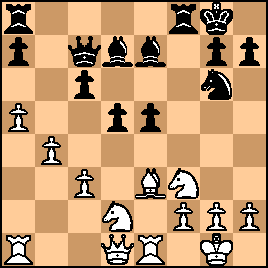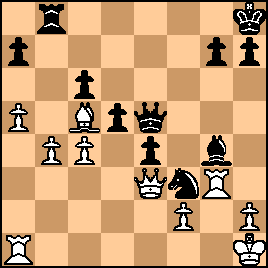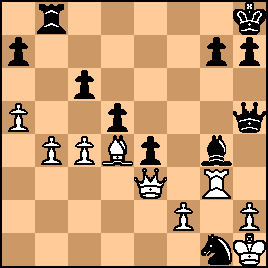| Aug-23-08 | | TheTamale: Why did Black resign? He could've played 34) ...Bd7!!! Then if the queen checks, 35) ...Be8 for the block!!! BLACK WINS!!! Sorry, I know everyone hates this type of kibitzing. It's just that I'm stuck at work on a Saturday... sigh. |
|
| Aug-23-08 | | najdorfman: TheTamale:
When strong players resign, it is NEARLY always for good reasons. I wish
kibitzers on this site would remember that before posting. 34...Bd7 35. Bxg7 check Kg8 36. Bh6
discovered check Kf7 37. Qxd7 check
is crushingly winning for White.
Sorry that you are stuck at work.... |
|
| Aug-23-08 | | TheTamale: Hi, Najdorfman. That's why I apoligized for the kibitzing... it wasn't serious analysis but rather a joke. I will admit that I didn't see your line, though.
Enjoy your day. |
|
| Aug-23-08 | | Once: After 34. Qc7 it's mate in 5.
The simplest response is 35 Qxd7 which poses just too many threats: 
click for larger viewWhite threatens both the back rank mate and Qxg7#. All black can do is throw in some spite checks to defer the end. 35. Bxg7+ also works, although it takes a little longer: 34. ... Bd7 35. Bxg7+ Kg8 36. Qd8+ Qe8 37. Be5+ Kf8 38.
Qf6+ Qf7 39. Rg8+ Kxg8 40. Qh8#

click for larger view |
|
Dec-28-21
 | | KEG: Napier thoroughly outplayed Albin and by move 18 had a winning exchange sacrifice combination beginning with 18...RxN. Napier could equally well have won with the same winning combination on move 19. Instead, and after having played so well to this point, Napier mysteriously waited to move 20 to play this exchange sacrifice--by which time it was no longer winning. Albin gave Napier another chance with his bad 26. Kh1?, but then fell apart--greedily trying to regain the exchange with 28...NxR? and then utterly blundering away the game with his horrendous 29...Qh5?? Given the move 30-time control at Monte Carlo 1902, and given Albin's failure to find the quickest winning move at move 30, it seems likely that time trouble was a factor--probably for both sides. 1. e4 c5
Announcing from the start that he was playing for a win. 2. c3
Albin playing the Alapin, perhaps to avoid prepared lines. A solid but not very aggressive variation. 2... d5
2...Nf6 is another well-known and good choice. After 2...d5, the position was:

click for larger view3. e5?!
3. exd5 is most usual and probably best.
3... Nc6
4. Bb5
4. d4 seems normal (if anything can be called "normal" in this unusual variation) and best. The text seems to contemplate the upcoming minor piece exchange. It is hard to understand why Albin chose to initiate this exchange. 4... Bd7
5. BxN

click for larger view5... bxB?!
Napier was clearly aiming for an unbalanced position, else he would doubtless have played the solid 5...BxB leaving him with whatever edge existed in the game. 6. d4
Not awful but difficult to understand. Why help Black solve his problems when he could just have played 6. Nf3 or 6. d3 or 6. b3. 6... e6
Declining to solidify White's center with 6...cxd4 7. cxd4, though this would have corrected the one flaw in Black's pawn structure. After 6...e6, the position was:

click for larger view7. dxc5?!
Since Albin won this game, second-guessing his moves may be doubtful. But, having said that, I fail to understand this move at all. It only strengthens Black's structure, while 7. Nf3 or 7. Ne2 look like solid developing moves that leave White reasonably well off (i.e., about even). 7... Bxc5
8. Nf3
Curiously, this was Albin's only move developing a minor piece until 15. Be3. Very strange. 8... Ne7
9. 0-0 Ng6

click for larger viewAfter some not terribly inspired play by Albin, Napier had emerged from the opening with a small edge. One might now have expected Albin to begin developing his Queen-side minor pieces, perhaps preceded by 10. c4. But instead, Albin commenced a bizarre Queen-side advance that was worse than useless. |
|
Dec-28-21
 | | KEG: Post II
10. a4?!
Very strange. There is obviously no threat of b5 from Black (who lacked a b-pawn at this stage), so why play this instead of developing or perhaps playing either 10. c4 directly (or after 10. Qe2 first)? 10... 0-0
Meanwhile, Napier played logical chess.
11. a5?!
Continuing with his ill-conceived scheme and lleaving: 
click for larger view11... Qc7
12. Re1 f6
12...Rab8 and 12...Be7 were also good.
13. b4 Be7
14. exf6 Bxf6
15. Be3
Finally deigning to begin developing his pieces! 15... Be7
16. Nbd2 e5!

click for larger viewBy any reckoning, Napier had the far superior position, though probably not a theoretically winning one yet. 17. Qb3 Rab8
18. Ne4?
This looks clever, but in fact should have lost Albin the game. He had nothing better than to hunker down with 18. Qa2 or 18. Kh1 or to play 18. a6 After 18. Ne4?, the position was:

click for larger view18... Kh8
I imagine that most strong players after even a glance at the position would consider 18...RxN. In fact, White would then be busted after 19. gxR Nh4 20. Kh1 Nxf3, Black's attack being overwhelming. In fact, Napier DID consider RxN, and indeed played it two moves later when it was no longer a winning maneuver. Again, very strange.
Napier's move at least had the virtue of getting his King off the a2...g8 diagonal. In addition, Black likely still had a theoretically won game, the position now being: 
click for larger viewWith the Black King now on h8 instead of g8, Albin pretty much had to play 19. Ned2, though he would still be in trouble after 19...e4! But instead, Albin now played:
19. Nc5?

click for larger viewNow, yet again, Napier had a winning combination beginning with 19...RxN! And yet again he flubbed it, this time giving away his winning advanatge: 19... BxN?
20. BxB

click for larger viewOnly now, when it was no longer a winning move, did Napier try the exchange sacrifice with: 20... RxN?!
20...Rf6 was perhaps slightly better, although the text was not a mistake (only a mystery--why play it only now rather than on move 18 or move 19 when it would have given Napier a decisive advantage. 21. gxR Nh4

click for larger viewThe position was now very complicated with chances for both sides. And, as will be seen, there was plenty of excitement and strange play in the remaining 13 moves. |
|
Dec-28-21
 | | KEG: Post III
22. c4! Be6
Better than 22...dxc4 23. Qe3 Bh3 24. f4 Bg4 25. Qg3 Nf3+ 26. Kg2 NxR+ 27. RxN Be6 28. Rxe5 after which Black would be a pawn to the good but White would have better targets (the Black isolated c-pawns are weaker than the White isolated f-pawns. 23. f4 e4

click for larger view24. Re3
Albin still doesn't appear to gained the thread of the game. 24. Qg3 is the way to neuter Black's attack, with 24. cx5 a close second choice. After the text, Albin again had worries on the King-side. 24... Qxf4
25. Rg3 Nf3+

click for larger view26. Kh1
I had originally thought this was a mistake, but on reflection it is no worse than 26. Kg2 (my earlier choice). 26... Bg4?
Very bad. Now, suddenly, Black's attack is at an end. Better were 26...Qe5 or 26...Qf6. 27. Qe3
27. Qc3 was more accurate.
White gets nothing from 27. Qxa7 in light of 27...Rb7. 27... Qe5

click for larger viewNow, things got really strange.
28. Rag1?!
"!!"--(Tournament Book)
"White's attack i irresistible." (Tournament BooK) Huh!!
While it is true that Black will get into trouble if he tries to snatch the Rook, but--as will be seen--that was entirely unnecessary. White would be fine with 28. Rc1 or 28. Rb1. But the position now was:

click for larger viewNow Black need only restrain himself from Rook snatching and remember to protect his King. Either 28...h5 or 28...Rd8 leaves Black with an edge. But instead, Napier (perhaps in time trouble) played: 28... NxR?
Now, like magic, Albin had a strong--though still hardly decisive--attack. 29. Bd4!
Of course:

click for larger viewNow, the question was: how if at all could Black save the game? There were still a few twists and turns to come before this game went into the record books. |
|
| Dec-28-21 | | ndg2: I don't like this game: seems to me, that Albin played largely anti-positional moves in the opening giving Napier a big advantage at one time. |
|
Dec-28-21
 | | KEG: <ndg2>I don't much like the game either. Neither player should be happy with their performances (though Albin was likely happy with the result). |
|
Dec-28-21
 | | KEG: Post IV
The next few moves were almost certainly played in a time scramble. It is thus perhaps unfair to present critical analysis (I, after all, had all the time I wanted plus computer assistance to make sure I don't blunder). Not having these benefits, Napier tossed away the game with: 29... Qh5??
Even with all the above disclaimers, this was a really bad move. Did he really think he could set up a mating net before he got mated himself? The only way to protect the Black Bishop, while defending against the threats to his g7 as well as against back rank mates was to play the one and only saving move: 29...Qf5. This is not that hard move to find, so I am fairly certain that Napier was in very severe time trouble. After 29...Qh5?, the position was:

click for larger viewNow, thanks to Napier's failure to cover the f-file with 29...Qf5, Albin had the completely crushing 30. Qf4! After that killer, Napier would have faced an immediate massacre. But, probably also being in severe time trouble, Albin played the natural-looking but inferior: 30. KxN
This move also wins fairly easily, the position now being: 
click for larger viewThings still looked grim for Napier, and I'm sure he was still in desperate time trouble. The only moves that would offer even token resistance were 30...Rb7, 30...Rg8, and maybe 30...dxc4. But instead, Napier played:
30... Rxb4?
This left:

click for larger viewIt almost looks as if Napier was trying to solve a help-mate problem. Why else leave both his back rank undefended and his g7 pawn insufficiently defended. Albin now could have ended the game with the devastating 31. Bxg7+, if then 31...Kg8 then 32. h3 is game over, and if instead 31...KxB then 32. Qf4!is a killer. Albin was now past the move 30 time-control. But he missed 31. Bxg7+ and instead player a move which also wins albeit less immediately: 31. h3
Napier was now in desperation mode:
31... Rb1+
32. Kh2
All the ups and downs notwithstanding, Napier was still very much lost: 
click for larger view32... c5
A futile gesture, but everything else is hopeless as well. 33. Qf4
Again missing the faster 33. Bxg7+. But the text wins almost as easily, the position now being: 
click for larger view33... Bf5?
The fastest way to lose. But in fairness to Napier the "better" 33...Qf5 34. Qd6 h5 (there is nothing better) 35. hxB hxg4 36. Qh6+ Qh7 37. Bxg7+ Kg8 38. Rxg4 would not have been much fun for him. After 33...Bf5, Albin closed proceedings with the nasty: 34. Qc7
34. Qd6 would also be devastating.
The position after 34. Qc7 was:

click for larger view1-0
To the extent there is any question that Napier's resignation was appropriate, please see the 2018 posts by <Once> and <najdorfman>. As they have pointed out, Napier could--at best--only have delayed mate for a few moves. |
|
|
|
|





